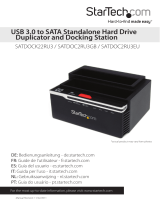
Quick Start Guide
“Retriever”
EN-CAHDD2BU3C-ZB
4. 5.
Contact Us
Call: 800.238.4453 (toll-free, USA only)
805.426.1000
Email: customer support@cavalrystorage.com
Website: www.cavalry storage.com
6.
1. Insert the 2.5” or 3.5” SATA drive(s) into either bay on the dock. Check
that the drive(s) is/are firmly inserted into the dock.
Note: Ensure a proper connection
when inserting a drive by putting it
straight down and not tilting it. If a
drive is not detected, turn off
the dock, remove and re-insert
the drive.
2. Connect the Power and USB cables, then turn the dock on. Wait for the
connected drive(s) to appear. If your drives are new or have been formatted
on a different computer, they may need to be initialized and formatted before
they can be used in Standard mode. Please keep in mind that formatting your
drive(s) will erase all data.*
*For Initialization and Formatting Guides, please refer to the product manual
and Tech Guides at http://www.cavalrystorage.com/manuals.aspx.
Note: Depending on the
drives used when powering
on, allow up to 30 seconds
for both drives to spin up
to speed.
Note: Removing the hard drives from the dock while it is being accessed may result in data loss. Before turning off the dock,
make sure the hard drives are not busy by checking-for a solid green “Hard Disk Access” light located on the front of the dock.
Standard HDD Docking Setup
1. Power Light
2. HD Access Lights x2
3. Duplicate Button (DB)
4. USB 3.0 Port [Also compatible with USB 2.0/1.1]
5. DC Power Input [12V]
6. Power Button
Disk Duplication Setup
3.
1.
2.
3. Once you have verified that the drives have the correct format
and file-systems, you may begin transferring data to the drives.
For Disk Duplication, please see the instructions to the right.
Standalone HDD Duplicator
and
USB 3.0 Dual-bay Dock
The Retriever offers two modes: (1) A regular dual-bay dock to access drives separately (JBOD) on the computer via USB. (2) A standalone duplicator that
makes an exact copy of any hard drive. If the original drive is bootable, the target drive will also be bootable. There is no limitation on OS, format or data type.
Troubleshooting
The HD Access lights do not flash green after pressing the duplicate
button for more than 3 seconds.
-Make sure the power is on and both drives are fully seated in the bays.
The HD 2 (target drive) Access light is red.
-The target drive is lower in capacity than the source drive. Or the target
drive is defective.
The HD 1 (source drive) Access light is red.
-The source drive is blank. Make sure the original drive with data is in Bay
1 and the blank drive is in Bay 2
What do the different combinations of lights mean?
- Refer to the bottom of the dock to view the “LED Status Table”
1. Insert the source drive (original 2.5” or 3.5” drive with data to be copied)
into Bay 1 (rear bay closest to the power switch and input)
2. Insert the target drive (blank drive) into Bay 2 (closest to the front of the
dock). If the target drive already has data on it, everything will be erased
once duplication has begun. Target drive must be equal to or larger in
capacity than the source drive.
3. Connect the power cord to the dock.
4. Press the Power button and the Power
light will turn on.
5. Ensure that the USB cable is NOT connected to the
dock AT ANY TIME during the duplication process.
6. Once both drives have been properly inserted, wait 60 seconds for both
drives to spin up, then press and hold the Duplicate Button (DB) for 3
seconds to begin the duplication process. The HD Access lights will begin to
blink steadily green to show that data is currently being copied from the
source to the target drive. Do NOT press the DB button again until the
process has completed, otherwise duplication will stop and you must restart
the process from the beginning and it will not resume from where it left off.
7. Depending on the amount of data being transferred, it may take up to
several hours to complete duplication. When completed, both HD Access
lights will be solid green (non-blinking).
8. It is now safe to plug in the USB cable to check if both drives are
identical. If the target drive is larger than the source drive, then any
additional space would be “unallocated”. Use Disk Management (Windows)
or Disk Utility (Mac) to extend the existing partition or to create a new
partition in the unallocated space.
Bay 1
Bay 2


